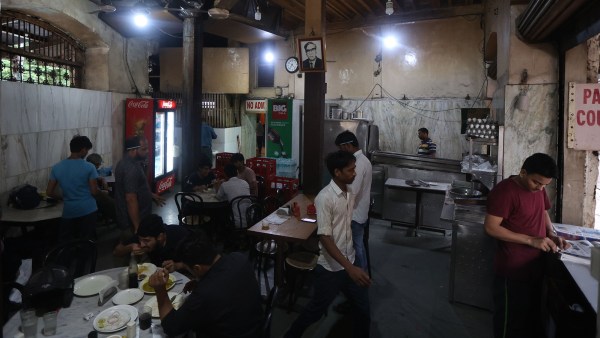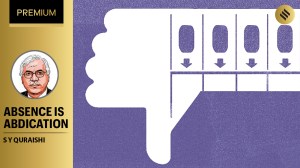Around Town: Inside 104-year-old Sarvi, one of Mumbai’s oldest restaurants that continues to dish out best seekh kebabs
Sarvi was established in 1920 by Haji Ghulam Alli Sarvi, a gentleman of Irani descent.
 Masoor pulav, seekh kebab and paya soup at Sarvi.
Masoor pulav, seekh kebab and paya soup at Sarvi.They say if you are looking for the best seekh kebab in the city, Sarvi is the place to go. For generations, loyal patrons—like Boman Irani who went on record to share how his father used to enjoy their seekh kebab and now he, his son and grandson devour them as well — attest to its consistently excellent taste. But what’s the secret behind delivering top-notch kebabs for over 100 years?
“It is the barkat of this place. Many have learnt here and moved on to other restaurants but none could replicate the taste,” said Mohammad Reza Paknejad, an 80-year-old Irani gentleman and a mechanical engineer from Matunga-based VJTI Mumbai. He has been managing the establishment for the past 50 years. “We are also good paymasters — the meat arrives in the morning, and we settle the account in the evening,” he noted, adding that they also buy buffalo meat — a key ingredient at the establishment — in bulk. “Since we buy kilos and kilos of it, we are able to segregate different parts for different preparations, reserving the best for seekh kebabs.”
Parked at a corner premise opposite Nagpada Police Station, Sarvi is spread across 2,000 sq ft and has no signboard. But because this unassuming place has been parked at the same spot for over 100 years and has a loyal base of customers, such fineries have no bearing on its sales, which start as early as 5.30 am. “As Boman (Irani) mentioned in his interview, ‘Sarvi is so famous that it doesn’t need a board,” he laughed.
 Mohammad Reza Paknejad, an 80-year-old Irani gentleman and a mechanical engineer from Matunga-based VJTI Mumbai. He’s been managing the establishment for the past 50 years. (Express Photo by Amit Chakravarty)
Mohammad Reza Paknejad, an 80-year-old Irani gentleman and a mechanical engineer from Matunga-based VJTI Mumbai. He’s been managing the establishment for the past 50 years. (Express Photo by Amit Chakravarty)
Going back in time
Sarvi was established in 1920 by Haji Ghulam Alli Sarvi, a gentleman of Irani descent. “It was his uncle who came to India and called him here. Sarvi understood food. Within a couple of years, he invited a specialist from Iran to make seekh kebabs here and what he did has been maintained since,” shared Paknejad, adding that Sarvi was a title he was bestowed with courtesy of his house being located on the first lane of his village near Yazd.
Legend has it that writer and playwright Saadat Hasan Manto was a regular at Sarvi. While Paknejad, also an Iranian who was asked by Sarvi’s son to manage the restaurant in 1974, can’t confirm or deny this piece of information, he shares that he has seen a lot of celebrities dining at Sarvi during his time at the restaurant, including actors Mahmood and Madhubala. “I have also heard about Raj Kapoor.”
In matters of taste
Sarvi’s menu features various dishes, with seekh kebabs, tandoori roti, paya soup, and masoor pulav being the most popular. The seekh kebab, once priced at Rs 2, is now Rs 50 in the air-conditioned mezzanine and Rs 40 on the ground floor.
We sampled Sarvi’s specialty, the buff seekh kebabs, which delivered on flavour as always. The kebabs, served with a runny mint chutney, were tender and flavourful with a melt-in-the-mouth texture. Unlike many places, they aren’t overly spicy or heavy; the balance of masala is subtle and just right. Each serving comes with a plate of mint leaves and lemon slices. “Kebab is very hot in nature. The mint leaves help cool it down and aid digestion, which is why we recommend chewing on them,” shared Paknejad.
 Inside Sarvi, an 104 years old establishment in Mumbai, which is widely known for its seekh kebabs. Legend has it that writer and playwright Saadat Hasan Manto was a regular at Sarvi. (Express Photo by Amit Chakravarty)
Inside Sarvi, an 104 years old establishment in Mumbai, which is widely known for its seekh kebabs. Legend has it that writer and playwright Saadat Hasan Manto was a regular at Sarvi. (Express Photo by Amit Chakravarty)
He also noted that their keema and kebabs are so good that even local butchers come to their restaurant. Each dish at Sarvi, we learnt from him, is prepared twice daily to ensure optimal flavours. Additionally, they grind their spices in-house and avoid red chilli powder, using green chilli to achieve the right level of spiciness.
While the paya soup was dominated by turmeric, the masoor pulav was a highlight. This dish, popular in some Muslim communities but rare in restaurants, featured rice, whole masoor dal, and mutton keema. It offered a delicate meaty flavour with a dash of tanginess and a satisfying texture from the masoor dal.
Going forward
Paknejad’s son, Ali, has various expansion ideas, but the old man is hesitant. “We need a consistent supply of high-quality buffalo meat, and transporting it across the city has become increasingly difficult. It’s only feasible in areas like Kurla or Jogeshwari,” he explained. For now, Paknejad continues to come to the restaurant daily, arriving by noon, taking his round, heading to his nearby office and returning at 3 pm for lunch, which includes paya soup and tarkari (sabzi) that he brings from home. “I believe it’s important to be home for dinner with my family. I’ve told Ali to maintain the current setup while I’m alive, and then he can expand as he wishes,” he added.












